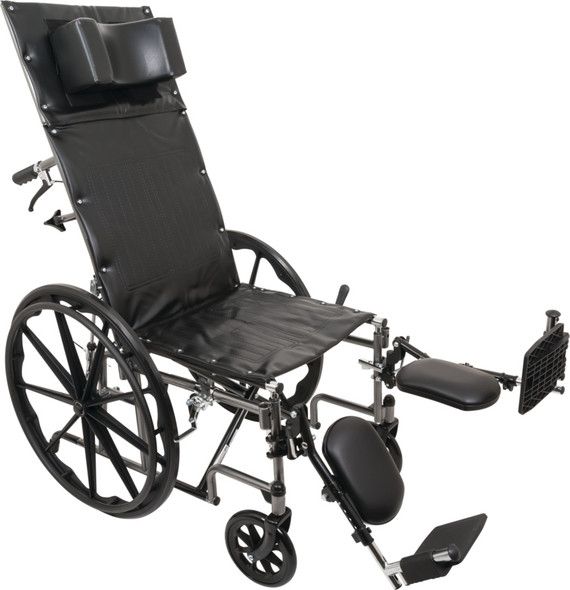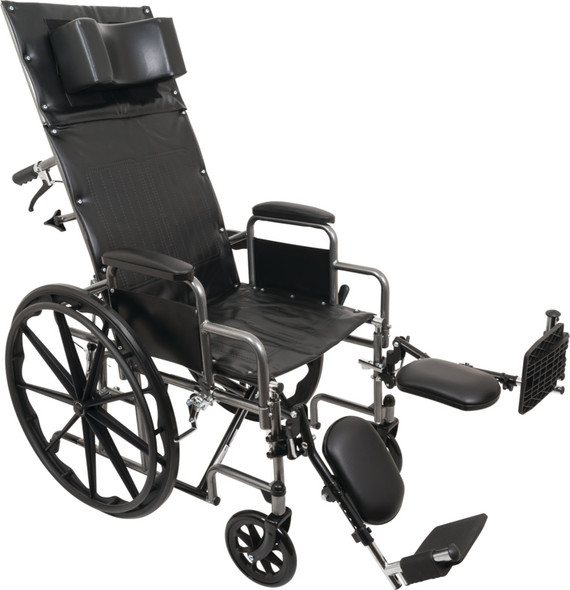Manual Wheelchairs
Manual Wheelchairs are versatile and reliable mobility aids designed for individuals who need assistance with movement. Operated by the user or a caregiver, manual wheelchairs provide a cost-effective and lightweight solution for indoor and outdoor mobility. With a variety of styles, including folding frames, reclining options, and bariatric models, manual wheelchairs cater to a wide range of mobility needs, offering comfort, independence, and ease of transport.
Why Manual Wheelchairs Are Essential
Manual wheelchairs offer freedom of movement for individuals who cannot walk or require mobility support. They provide a simple, practical solution for navigating daily life, improving independence, and enabling users to participate in activities. Lightweight and portable, manual wheelchairs are ideal for temporary or long-term use, offering a dependable alternative to powered devices.
What Are Manual Wheelchairs?
Manual wheelchairs are non-motorized mobility devices propelled either by the user using hand rims or by a caregiver pushing the chair. They are designed to be lightweight, durable, and adjustable to meet individual needs. Manual wheelchairs come in various models, such as standard, transport, reclining, and bariatric, making them suitable for diverse applications, from everyday mobility to medical recovery.
Types of Manual Wheelchairs
1. Standard Manual Wheelchairs
Best for: Daily mobility for users with moderate strength.
Standard manual wheelchairs are durable and easy to use, offering a dependable solution for individuals with general mobility needs.
Key Features
- Foldable frames for easy transport and storage.
- Adjustable footrests and armrests for comfort.
- Padded seats and backrests for support.
Applications
- Indoor and Outdoor Use: Provides reliable mobility for various settings.
- Temporary Recovery: Assists during short-term rehabilitation.
- Caregiver Assistance: Suitable for users who require pushing support.
2. Lightweight Manual Wheelchairs
Best for: Users who need a portable and easy-to-maneuver option.
Lightweight wheelchairs are designed for effortless handling and transport, ideal for active users or frequent travelers.
Key Features
- Lightweight aluminum or titanium frames.
- Compact, foldable designs for portability.
- Smooth rolling wheels for easy navigation.
Applications
- Travel: Perfect for trips and daily commutes.
- Active Users: Supports individuals who self-propel frequently.
- Medical Appointments: Easy to transport and store during visits.
3. Reclining Manual Wheelchairs
Best for: Enhanced comfort and pressure relief for long-term use.
Reclining manual wheelchairs offer adjustable backrests and leg supports, making them suitable for individuals requiring additional support or pressure management.
Key Features
- Adjustable reclining backrest for user comfort.
- Detachable leg rests for customizable positioning.
- High backrests and headrests for extended support.
Applications
- Post-Surgery Recovery: Provides a comfortable seating option for extended periods.
- Chronic Conditions: Supports individuals with limited strength or stability.
- Elderly Users: Offers added comfort and relaxation.
4. Bariatric Manual Wheelchairs
Best for: Individuals requiring heavy-duty support and wider seating.
Bariatric wheelchairs are specifically designed to accommodate higher weight capacities while ensuring durability and comfort.
Key Features
- Reinforced frames for enhanced durability.
- Wider seats to ensure user comfort.
- High weight capacity for safety and stability.
Applications
- Plus-Size Users: Offers safe mobility for heavier individuals.
- Chronic Conditions: Supports users with obesity-related mobility challenges.
- Healthcare Facilities: Reliable option for hospitals and clinics.
5. Transport Wheelchairs
Best for: Caregiver-assisted mobility for short distances.
Transport wheelchairs are lightweight and compact, designed for easy use by caregivers during travel or medical appointments.
Key Features
- Compact frames for convenient handling.
- Smaller rear wheels for caregiver operation.
- Foldable designs for portability.
Applications
- Travel Assistance: Ideal for trips and outdoor activities.
- Hospitals and Clinics: Provides mobility for patients during appointments.
- Caregiver Use: Simple and efficient for pushing and storage.
Key Features of Manual Wheelchairs
- Foldable Frames: Allows for easy transport and storage.
- Adjustable Components: Includes height-adjustable footrests, armrests, and backrests.
- Lightweight Materials: Aluminum and titanium frames for portability and durability.
- Comfort Enhancements: Padded seats and ergonomic designs to reduce fatigue.
- Customizable Options: Available in various seat widths, wheel sizes, and reclining features.
- Durability: Sturdy construction ensures long-term use and reliability.
Real-World Use Cases
Case 1: Post-Surgery Recovery
A patient recovering from a hip replacement used a reclining manual wheelchair for added comfort and support during their rehabilitation period.
Case 2: Elderly Mobility
An older adult with balance challenges relied on a standard manual wheelchair for daily movement within their home and outdoor spaces.
Case 3: Travel Assistance
A caregiver used a lightweight transport wheelchair to take a family member to medical appointments and outdoor excursions.
Case 4: Bariatric Mobility
A bariatric patient utilized a reinforced manual wheelchair to navigate their home and attend physical therapy sessions.
How to Choose the Right Manual Wheelchair
- User Strength: Choose a lightweight model for users who self-propel and a standard or transport wheelchair for caregiver assistance.
- Comfort Needs: Select reclining or padded models for extended use.
- Portability: Opt for foldable designs for travel or easy storage.
- Weight Capacity: For heavier users, bariatric models provide safety and durability.
- Intended Use: Consider specific applications such as indoor, outdoor, or medical use.
- Professional Advice: Consult with a healthcare provider to identify the best option for your needs.
How to Use Manual Wheelchairs
- Adjust for Comfort: Customize the footrests, armrests, and seat height to suit the user.
- Practice Propulsion: Learn how to self-propel using the hand rims or operate the chair with a caregiver.
- Safety First: Use brakes when stationary and avoid uneven surfaces.
- Maintain Regularly: Inspect wheels, brakes, and frames for wear and tear.
- Store Properly: Fold the wheelchair for easy storage when not in use.
Benefits of Manual Wheelchairs
- Cost-Effective Mobility: Affordable compared to powered options.
- Lightweight and Portable: Easy to transport and maneuver.
- Customizable Features: Tailored options for comfort and usability.
- Independence: Allows users to move freely without relying entirely on caregivers.
- Versatility: Suitable for short-term recovery, long-term use, or travel.
Frequently Asked Questions (FAQs)
1. Are manual wheelchairs covered by insurance?
Yes, many manual wheelchairs are covered by insurance or Medicare if prescribed for medical use.
2. How do I choose the right size manual wheelchair?
Measure the user’s seat width, height, and weight to select a wheelchair that fits comfortably and securely.
3. Can manual wheelchairs be used outdoors?
Yes, most manual wheelchairs are designed for both indoor and outdoor use, but lightweight or all-terrain options may be more suitable for frequent outdoor activities.
4. Are manual wheelchairs easy to transport?
Yes, most manual wheelchairs have foldable frames, making them easy to carry and store.
5. How often should manual wheelchairs be maintained?
Regular maintenance, such as inspecting tires, brakes, and frames, should be performed monthly or as needed.
Related Products
Enhance your manual wheelchair experience with wheelchair cushions, anti-slip footrests, and storage pouches. Explore our lightweight ramps and portable lifts for added accessibility. Visit our blog for expert tips on choosing and maintaining manual wheelchairs.
Feel confident and mobile with our high-quality Manual Wheelchairs, designed for comfort, portability, and reliability. From standard to lightweight models, we offer solutions to suit every need. Shop now and find the perfect fit for your mobility!
-

ProBasics K7 Heavy Duty Wheelchair – 24–28 in Seat Width, 450–600 lb Capacity, Silver Vein Steel Frame
Compass Health
$494.99ProBasics K7 Heavy Duty Wheelchair is designed for those who need extra support and comfort, offering a wider seat and higher weight capacity for peace of mind. Whether you are a bariatric patient or a caregiver seeking a reliable mobility solution, this...- SKU:
- WC72418DE
$494.99 -

ProBasics Heavy Duty K0007 Wheelchair – 24 X 18 in Seat, 450 lb Capacity, Removable Desk Arms
Compass Health
$449.99ProBasics Heavy Duty K0007 Wheelchair is designed for users who need extra support and comfort in a bariatric wheelchair. If you require a wider seat and higher weight capacity, this model offers a sturdy solution for daily mobility. Ideal for bariatric...- SKU:
- WC72418DS
$449.99 -


ProBasics Reclining Wheelchair – 18 X 17 in Seat, Removable Desk Arms, Reclines 90–160°, 300 lb Capacity
Compass Health
$476.99ProBasics Reclining Wheelchair is designed for those who need reliable comfort and full back support throughout the day. Whether you are a caregiver assisting with transfers or a user seeking a supportive mobility solution, this chair adapts to your...- SKU:
- WCR1816E
$476.99 -


ProBasics Reclining Wheelchair – 20 X 17 in Seat, Removable Desk Arms, Elevating Legrests, 300 lb Capacity
$489.99ProBasics Reclining Wheelchair is designed for those who need full back and headrest support throughout the day. Whether you are a caregiver assisting with daily mobility or a user seeking comfort during extended periods of sitting, this wheelchair...- SKU:
- WCR2018E
$489.99 -


Blue Streak Lightweight Folding Wheelchair – Durable, Comfortable & Easy to Maneuver
Drive Medical
$271.25 - $419.75Durable, Powder-Coated Frame: Sturdy blue powder-coated steel frame with black cross brace for long-lasting use. Comfortable & Supportive: Flip-back, padded desk-length arms and durable nylon upholstery ensure user comfort and easy maintenance...$271.25 - $419.75 -


McKesson Lightweight Transport Chair – Folding, Aluminum Frame, Swing-Away Footrests
McKesson
$219.25 - $264.25The McKesson Lightweight Transport Chair is designed for smooth mobility, easy caregiver operation, and compact storage. Unlike standard wheelchairs, this lightweight aluminum transport chair features small rear wheels, ergonomic push handles, and a...$219.25 - $264.25 -


McKesson Reclining Wheelchair – Single Axle, 180° Full Back Support, Elevating Leg Rests & Detachable Arms
McKesson
$439.25 - $568.15The McKesson Reclining Wheelchair is designed for enhanced comfort, positioning support, and medical-grade durability. Featuring a hydraulic reclining backrest, this wheelchair adjusts up to 180 degrees, providing full-body support, pressure relief, and...$439.25 - $568.15 -


McKesson Lightweight Silver Vein Transport Chair – 19" Seat, Foldable, 250 lb Capacity
McKesson
$257.99The McKesson Lightweight Silver Vein Transport Chair is designed for effortless mobility, safety, and comfort, making it ideal for home care, travel, and medical facilities. Built with a durable steel frame, this chair supports up to 250 lbs while...- SKU:
- 146-TR39E-SV
$257.99 -


Extra-Wide Bari+Max Reclining Bariatric Wheelchair with Elevating Leg Rest – 28" Seat
Dynarex
$2,679.99The Dynarex Extra-Wide Bari+Max Reclining Bariatric Wheelchair with Elevating Leg Rest – 28" Seat provides superior comfort, durability, and support for individuals requiring a heavy-duty mobility solution. Designed with a steel frame, full...- SKU:
- 15015-28DELR
$2,679.99 -


Adult Folding Tilt-In-Space Wheelchair – Adjustable 45° Tilt
$2,195.99The Kanga Adult Folding Tilt-In-Space Wheelchair by Drive Medical delivers unmatched versatility and comfort with its advanced tilt-in-space technology. With an impressive 45° tilt range, this wheelchair is designed to provide optimal pressure relief...- SKU:
- KGA-8020-2GB
$2,195.99 -


Bariatric Sentra EC Heavy-Duty Wheelchair - 450 lb Capacity, Adjustable Height
Drive Medical
$711.99The Bariatric Sentra EC Heavy-Duty Wheelchair brings together strength, convenience, and user-focused design for individuals needing a robust and adaptable mobility solution. With an impressive weight capacity of 450 lbs and a customizable seat-to-floor...- SKU:
- STD22ECDFA-ELR
$711.99
